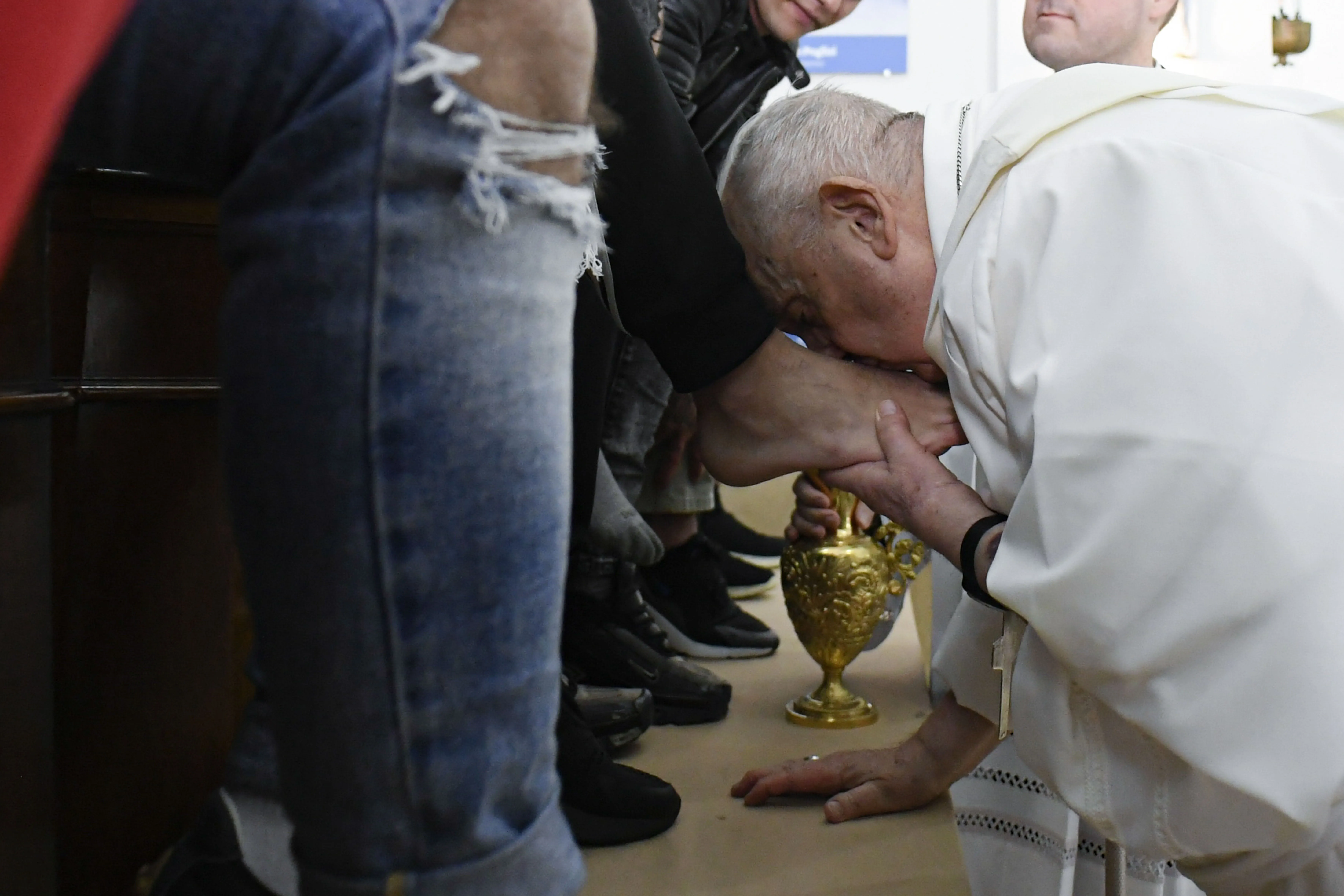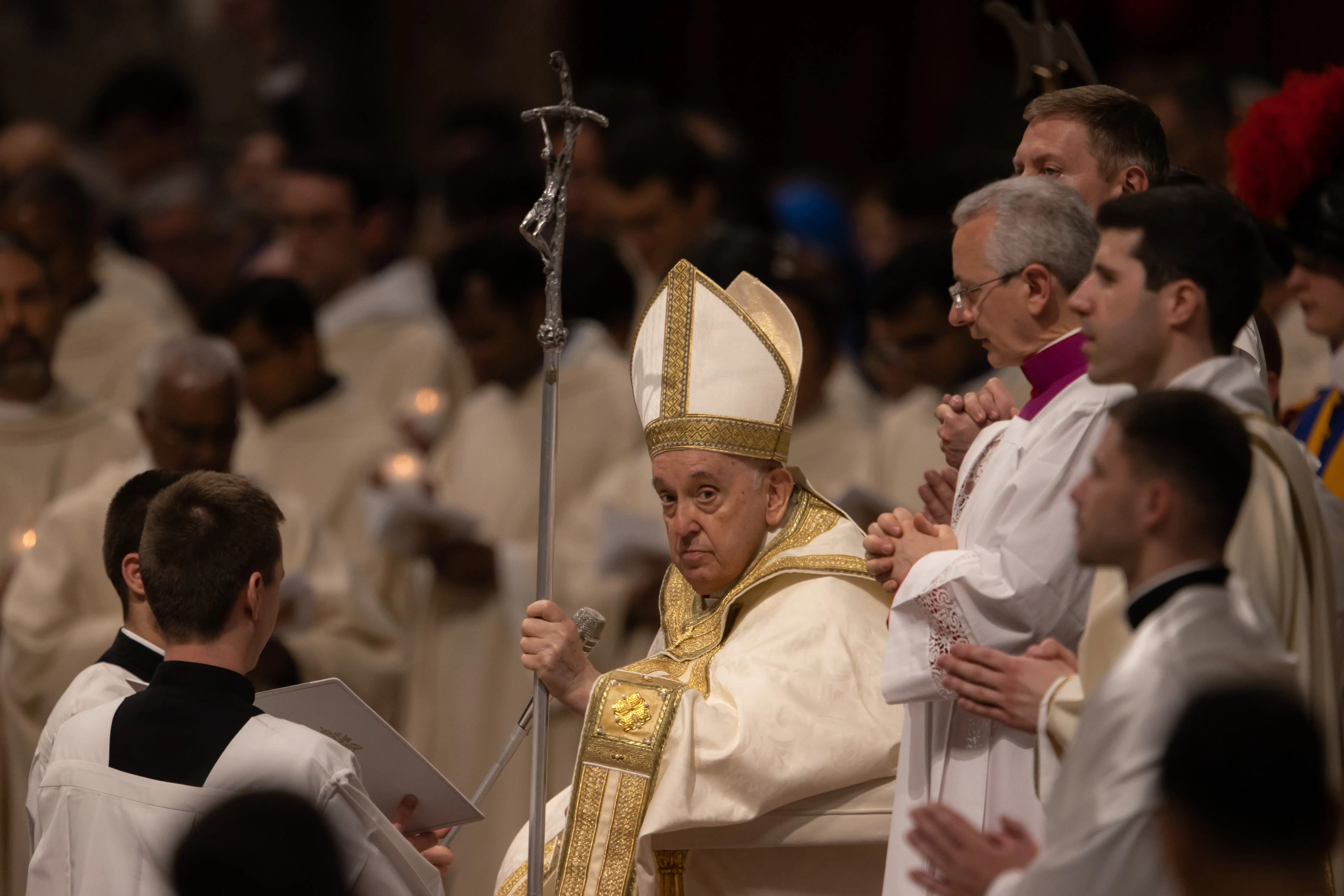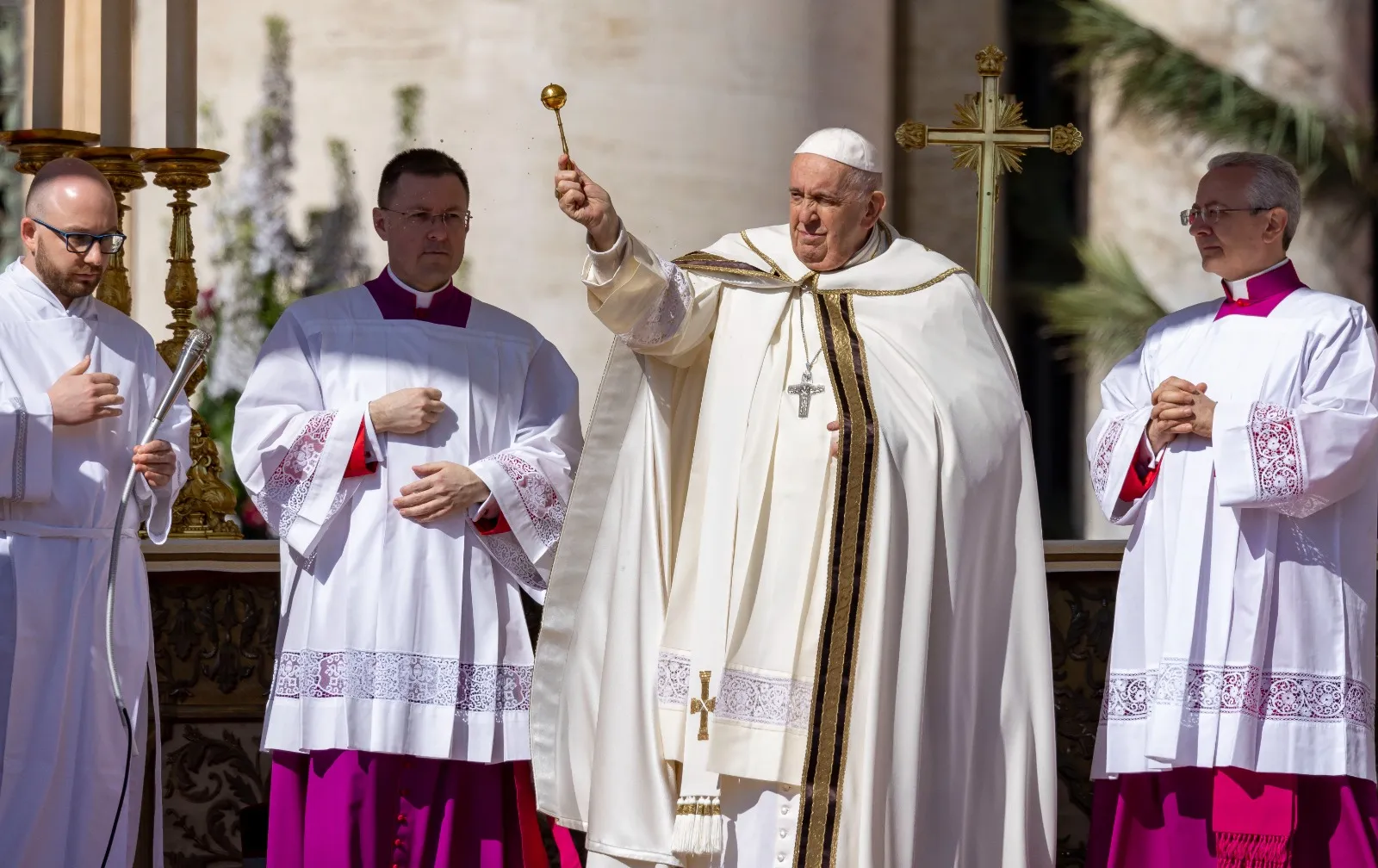
The following homily was preached by the Reverend Peter M. J. Stravinskas, Ph.D., S.T.D., for the Second Sunday of Easter/Divine Mercy Sunday [April 8, 2018], at the Church of the Holy Innocents, New York City.
An embarrassment of riches confronts us today as we observe the Octave Day of Easter, Dominca in albis, Divine Mercy Sunday, Low Sunday, Quasimodo Sunday – take your pick – with readings that lead us to such seemingly diverse things as the experience of peace, the means of forgiveness, the wounds of the Risen Christ, the meaning of faith. Believe it or not, they all fit together.
Like Christmas, Easter is one of those feasts the Church just can’t seem to let go of. We’ve been reminded of that liturgically all week by the special inserts into the Roman Canon, the solemn paschal dismissal, the Easter sequence, and the Gloria every day. The joy of Easter is so great, that the Church continues her celebration non-stop for a full week, but the mystery is so great that it really demands such attention. The ancient Hebrews were quite fond of octave feasts, so much so that they developed a special understanding of them: The eighth day symbolized for them, and later for the Fathers of the Church, the endless reign of the Messiah in an eternal Sabbath. And that’s what we commemorate today – an Easter that will never end. Let’s try to plumb the depths of this extraordinary, indeed central, mystery of our faith.
It is interesting to note that this Gospel passage is employed by every rite of the Church on this Sunday, obviously due to its connection to the eighth day since the Resurrection of the Lord of life. As the Risen Christ appears, as if from nowhere on Easter night, He offers the frightened apostolic band the standard greeting of Shalom [Peace]. It was not an empty greeting like “Hello”, for it signified a desire that the other receive the experience of harmony, health, healing, wholeness, union with God and neighbor. But Jesus wanted to make very sure that His Apostles understood the full import of His particular intentions on this night, therefore, He immediately went on to demonstrate that He had even more in mind. And so, He begins by making them His delegates or representatives in conferring such peace on others: “As the Father has sent me, so I send you.”
Now what? He breathes on them, but for what purpose? Being good Jews, the Apostles understood the significance instantly. The Hebrew word ruah means “breath” or “wind” or “spirit”. At the dawn of creation, the Book of Genesis tells us, the wind or breath of Almighty God swept over the waters, bringing forth life. In the second chapter of that inspired book, we are told that the Lord God formed the first human from the dust of the Earth and then “blew into his nostrils the breath of life, and so man became a living being” (Gen 2:7). Jesus clearly intends to bring about a re-creation of humanity as once more the breath of God confers His Spirit on men, restoring them to the fullness of life by the forgiveness of their sins. In other words, in this moment original sin and all personal sins are vanquished as man now is given the possibility of returning to the Garden of Eden.
And how is such a marvelous event to occur? Through Christ’s providence, the Apostles and their successors are to be the Risen One’s agents of this wondrous reconciliation between God and man. Too good to be true? Apparently so, for St. Thomas surely had difficulty imagining that any of it could be true, and in this way he stands for each one of us who also finds it hard to believe not only that our sins can be forgiven, with the whole slate wiped clean, but also that Christ could have risen from the dead. And so, our divine Savior uses Thomas’ hesitancy to believe to teach him – and us – some important lessons of Christian faith.
On the Octave of Easter, then, the Risen Christ reappears in the Upper Room – that same room where He instituted the Sacraments of the Eucharist and Holy Orders ten days earlier and where the Pentecost gift of the Holy Spirit will be bestowed forty days later. Once more, He greets His chosen disciples, but then quickly turns His full attention to Thomas. He wants to convince Thomas that He is truly risen, and He does so by pointing to His holy wounds.
Why? Those wounds on the Body of the Glorified and Risen Lord teach us several things. First, they show that this Jesus is not a ghost but a real flesh-and-blood Person. Second, they serve as powerful reminders of the great love of God for us, a love so great that in Christ God died, so that our sins might be forgiven. Third, those wounds illustrate the continuity between the earthly life and ministry of Jesus and His eternal high priesthood, by which He lives to make continual intercession for us before His Heavenly Father (cf. Heb 7:25).
It is not an accident that Thomas comes to faith, not by simply seeing an apparition of Jesus, but only after being instructed to pay heed to those sacred wounds, which are not scars of defeat and ignominy but, as the medieval mystic Julian of Norwich put it, noble “tokens of victory and love.” Because Jesus loved us to death, our sins are forgiven, and that love remains present in the Godhead forever. Therefore, when we meet Christ face to face on Judgment Day, He will look just as He did during that first Easter season: We will behold Him in glory, but a glory that still teaches us the price of sin. Seeing His wounds on that day will either bring us to the full awareness of what our sins have done and to perfect love of Him forever in Heaven or to hatred and envy of One Who has such a capacity to love and forgive, and that thought will banish us to Hell. Jesus, you see, is in a unique position to judge us, precisely because He shared our human condition completely and bore the burden of our sins, which is why the Father has given over to Him the role of judgment of the human race (cf. Jn 5:22). The judgment the Lord most desperately wants to make, however, is that of forgiveness, if only we allow Him to do so.
The Apostles impressed the inhabitants of Jerusalem with their “many wonders and signs” (Acts 2:43), however, the greatest signs worked by the Apostles and their successors are not physical cures but the inner healings which come from the Sacrament of Penance, established by our merciful Savior on this very night. We who have such ready access to this channel of grace know why the Angel of the Resurrection urges: “Do not be afraid” (Mt 28:5).
Six centuries after Julian of Norwich, in 1905 a girl was born to a poor but devout Polish couple. As a teenager, she entered the Congregation of the Sisters of Our Lady of Mercy in Warsaw. Because she was uneducated, Sister Faustina was assigned the most menial of tasks; in the midst of the tasks of a cook, baker, gardener and housekeeper, the young nun underwent many mystical experiences, during which Our Lord asked her to become both His apostle and His secretary — to announce anew to mankind the Gospel of God’s mercy. In one of the Lord’s messages to her, He said: “Mankind will not have peace until it turns with trust to my mercy. . . . My daughter, be diligent in writing down every sentence I tell you concerning my mercy, because this is meant for a great number of souls who will profit from it.”
Sister Faustina was also told that the Church should celebrate a feast in honor of the divine mercy – on the Sunday after Easter. Not by accident does the Church on that day read the Gospel text which recounts Christ’s institution of the Sacrament of Penance, which is the surest and clearest sign of the divine mercy. The young mystic likewise wrote down two prayers dictated to her by the Font of Mercy Himself. The first goes like this, as you well know: “Eternal Father, I offer you the Body and Blood, Soul and Divinity of your dearly beloved Son, our Lord Jesus Christ, in atonement for my sins and those of the whole world.” The second is like it: “For the sake of His sorrowful Passion, have mercy on us and on the whole world.”
Our Lord promised Sister Faustina that great things would happen if people prayed this chaplet of prayers with the proper attitude: “Whoever will recite it will receive great mercy at the hour of death. Priests will recommend it to sinners as their last hope of salvation. Even if there were a sinner most hardened, if he recited this chaplet only once, he will receive grace from my infinite mercy. I desire that the whole world know my infinite mercy. I desire to grant unimaginable graces to those who trust in my mercy.” Indeed, the Risen Christ’s first gift to His Church was His peace, which flows from His abiding mercy. We need to reflect on that and believe it with all our hearts, thanking God for this gift, which so many people desire and hope for but never realize is so readily available to them.
However, we must not lapse into some kind of soupy, saccharine understanding of mercy, whereby God simply rubber-stamps our sinfulness and tells us we are fine, just as we are. We cannot have access to what the Protestant theologian Dietrich Bonhoeffer condemned as “cheap grace.” There is no such thing as “cheap grace”; the only grace available to us is the grace won by Christ’s saving death. Hence, Bonhoeffer’s signature work is entitled, The Cost of Discipleship.” What cost Jesus His life has a cost for us as well. Dame Julian, in contemplating the wounds of Our Lord, also prayed for a wound for herself – the wound of true repentance, which entails not only sorrow for sin but a sincere purpose of amendment. Simply put: to claim mercy, one must see oneself as a sinner who hears Jesus say, “Neither do I condemn you,” yes. And then we have to hear the next sentence, too: “Go, and do not sin again” (Jn 8:11).
It should be no surprise, then, to find St. Augustine, playing with the origins of the Latin word for mercy [misericordia], as he informs us that God’s grace moves us “a miseria ad misericordiam” [from misery to mercy]. “Misericordia,” you see, comes from two words which combine to mean “having a heart for the miserable.”
The wonderful Dominican Sisters of Newburgh, who taught me in high school, made us memorize at least one Shakespearean soliloquy a year. In my freshman year, that came from The Merchant of Venice, wherein the Bard of Avon rhapsodized on the beauty and glory of mercy as he had Portia exclaim:
The quality of mercy is not strain’d,
It droppeth as the gentle rain from heaven}
Upon the place beneath. It is twice bless’d:
It blesseth him that gives and him that takes:
‘Tis mightiest in the mightiest; It becomes
The throned monarch better than his crown.
His sceptre shows the force of temporal power,
The attribute to awe and majesty,
Wherein doth sit the dread and fear of kings;
But mercy is above this sceptred sway,
It is enthroned in the hearts of kings;
It is an attribute to God Himself,
And earthly power doth then show likest God’s
When mercy seasons justice. Therefore, Jew,
Though justice be thy plea, consider this:
That in the course of justice none of us
Should see salvation. We do pray for mercy,
And that same prayer doth teach us all to render
The deeds of mercy.
As beautiful as that soliloquy is, as one commentator has observed, “before Shakespeare wrote it, God was it!”
As I mentioned, Faustina Kowalska was a member of the Sisters of Our Lady of Mercy. And so, it might behoove us to consider the Marian dimension of this as well. Indeed, God became Mercy Incarnate within the spotless womb of the Virgin Mary. And she understood it all so well that she broke forth into her canticle of praise, the Magnificat: “Et misericordia eius a progenie in progenies timentibus eum” [And His mercy is from age to age on those who fear Him]. Our Lady was not teaching theology from a textbook but from her own experience of life. God had touched her so profoundly by His mercy that she became what the Church’s lovely night prayer to her rightly calls her – “Mater misericordiae“ [Mother of Mercy]. God the Father sought the young maiden’s cooperation with His eternal plan of mercy; God the Holy Spirit overshadowed her with His merciful wings; she became the very seat of Mercy, the Mother of the One Who is “dives in misericordia” [rich in mercy], as the title of St. John Paul II’s encyclical reminds us.
Our world, my dear people, needs to hear the message of mercy perhaps as no other age before. A culture of violence, death, destruction and despair can be healed only by mercy. You and I, like St. Faustina before us, must count ourselves among the apostles of mercy. But first we must be convinced that mercy has been granted us; otherwise, our words will ring hollow. The result of knowing mercy (which comes from the very core or heart of the Being of God) means being grabbed at the very core or heart of our own being – and that gives birth to the emotion (both divine and human) of joy. Once more, Our Lady leads the way as she sings out: “Exsultavit spiritus meus in Deo Salvatore meo” [My spirit has rejoiced in God my Savior]. Where mercy spawns joy, melancholy, fear and death are definitively banished.
By a happy coincidence, we heard the First Epistle of St. John speak of the three witnesses: the Spirit, the water, and the blood (1 Jn 5:8). Are not the rays of blood and water the very symbols of the Divine Mercy devotion? Flowing from the wounded side of the Dead Christ were the streams of the sacramental life of Holy Church in those most basic and fundamental sacraments of Baptism and Eucharist. Lay claim to those grace-filled avenues of mercy in making your own the beautiful and moving Anima Christi:
Soul of Christ, sanctify me.
Body of Christ, save me.
Blood of Christ, inebriate me.
Water from the side of Christ, wash me.
Passion of Christ, strengthen me.
O good Jesus, hear me.
Within thy wounds hide me,
Suffer me not to be separated from Thee.
From the malicious enemy defend me.
In the hour of my death call me, and bid me come to Thee,
That with thy saints I may praise Thee for ever and ever. Amen.
If you value the news and views Catholic World Report provides, please consider donating to support our efforts. Your contribution will help us continue to make CWR available to all readers worldwide for free, without a subscription. Thank you for your generosity!
Click here for more information on donating to CWR. Click here to sign up for our newsletter.












Thank you for printing this beautiful homily.
Thank you, Father for the share. Lord, Jesus, we trust in You!